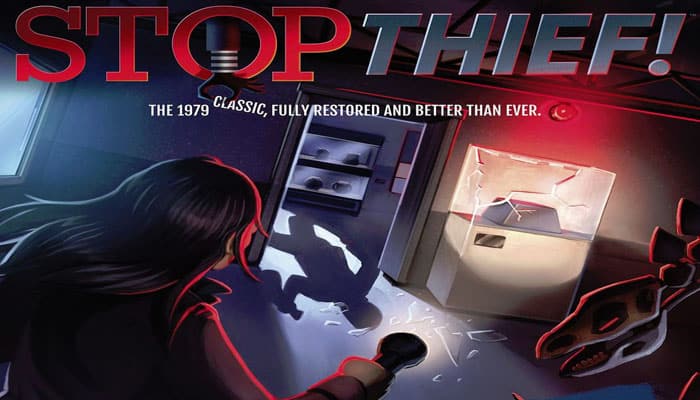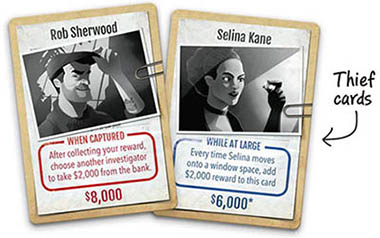
An alert pops up on your phone: A crime has just been committed! Grab your investigator's license and your keen powers of deduction and hunt down the thief.
But watch out, because you're not the only private eye on the hunt, and only one of you can slap the cuffs on the thief and claim the reward. Get enough reward money, and you can finally leave this rat race behind and retire to a sunny tropical beach in the Caribbean.
In Stop Thief!, players play private investigators trying to catch a thief secretly moving around the board. The thief does not physically appear on the board - the app keeps track of where the thief is and how they are moving and plays sounds to give clues about their location.
Use the sound clues to figure out where the thief is, then move there and arrest the thief, earning your reward.

Components
- 12 Thief Cards
- 1 Game Board
- 6 Investigator Meeples
- Money Cards
- 6 Investigator License Cards
- Rulebook
Note: You will also need an electronic device such as a smartphone or tablet and the Stop Thief! module in the Restoration Games app.
Object of the Game
Be the first player to collect enough cash to retire. The amount needed changes based on the number of players.
Setup
Place the game board in the center of the table and the money to the side to create a bank.
Shuffle the thief deck and place it face down next to the bank. Reveal the top card.
Each player takes an investigator meeple, its matching ID card, and takes all of their movement cards into their hand.
Place the investigator meeples on the subway space labeled
 in the center of the board.
in the center of the board.Everyone takes $3,000 from the bank.
Launch the app and choose a game mode. The app will tell you which player takes the first turn.
Game Play

Players take turns clockwise around the table. On your turn, do the following three steps in order:
- Get a Clue
- Play a Card
- Attempt an Arrest (optional)

I. Get a Clue
Press the GET A CLUE button on the app. The app will play a sound for everyone to hear - that's your clue to start figuring out where the thief is. The clue is not secret, so if someone missed it, you can replay it.
Rules for the thief's movement (in the standard game):
The thief always starts on a crime scene space.
The thief always moves from one numbered space to the next numbered space (including doors and windows) connected by a footprint path - skipping over the unnumbered circles.
The thief will not return to the space they just moved from the turn before.
The thief will sometimes stay in the same space.
If the thief moves onto a door or window space, they will go through it to the next room or outdoor space on their next move. (They won't go to a window, open it, and then go back into the room).
If a thief moves onto a subway space, they make the same sound as other outside spaces. They can walk on it like other numbered spaces, but they will not take the subway.
If the thief returns to a crime scene, they will rob it again. If they stay on it, they will keep robbing it. Crime Spree!

Crime Spree!
Sometimes, the sound clue reveals that the thief committed another crime by moving onto another crime scene space.
If that happens, take $1,000 from the bank and place it on the thief card. This is an additional reward for catching such a dastardly criminal.
II. Play a Card
Play a card from your hand onto the table. You may move a number of spaces up to the amount shown on the card.
Some cards have a special effect on them that will let you use its power before, during, or after your move. You do not need to move the full number of spaces on the card, and you are not required to do the effect.
Once you play a card from your hand, it stays on the table until an effect lets you pick up your movement cards. This is typically from another one of your movement cards.
Rules for investigators' movement:
-
Investigators must travel along the footprint paths using all the spaces, including the unnumbered circles. Exception: Investigators may not move onto or through a window space unless there is an effect that specifically lets them do so.
-
Investigators may move through a space occupied by another investigator, but they may not end their movement on a space with another investigator.
Exception: More than one investigator can be on the subway spaces.
-
If an investigator moves onto a subway space, they may move to any other subway space on the board for free. After moving to the new space, they immediately stop moving.
If the player has played a movement card that has an effect, they may still resolve the effect (even if that effect lets you move additional spaces).
-
Some thief effects might limit the number or type of spaces investigators may move onto.

Get to know the gameboard
The sound you hear tells you the new space that the thief went to:
Crime Scene sound: an alarm.
Inside a building sound: footsteps.
Subway sound: muffled speaker.
(In the standard game, thieves treat subways as regular outside spaces).
Door sound: a creaky door.
Window sound: breaking glass.
Outside a building sound: hubbub.
If you hear hold music, it means the thief stayed still.
Unnumbered circle spaces are only used by investigators - thieves skip over them.
Note: Thieves and investigators can move in either direction on the paths, regardless of which direction the footprints point.
III. Attempt an Arrest (optional)
You may attempt to make an arrest on the space you are on or any adjacent numbered space. Press the attempt an arrest button on the app. The number of the space where you are attempting the arrest is public.
Announce the number of the space you think the thief is on and enter it in the app. The app will then tell you if you are right or wrong.
-
If you are wrong, pay $1,000 to the bank. (If you have no money, nothing happens). Play then continues as normal to the next player on your left.
-
If you are right, the thief is arrested. You collect reward money as indicated on the thief card and any additional money if they went on a crime spree. If there is a "When Arrested" effect on the thief card, it happens. You make any decisions that need to be made for the "When Arrested" effect.
An investigator on this spot could choose to attempt an arrest on space 333 or space 324 (but nof 332 - it is not adjacent).
Starting a New Round
After a successful arrest, if the game is not over, the player to your left starts the next round, with investigators continuing from their current spaces on the board. Discard the card of the thief who was caught and reveal a new one.
End of the Game
The first player to get enough cash to get out of this two-bit job is the winner.

Difficulty Settings
Since 1979, technology has advanced just a teeny, tiny bit. While the big blocky Crime Scanner was a marvel of its time, we can now do what it did in an app-and a whole lot more.
By using an app, we are able to update the game after you already have it, including whole new ways to play. The app will tell you what different ways there are to play and how to play them.
Continue Reading

